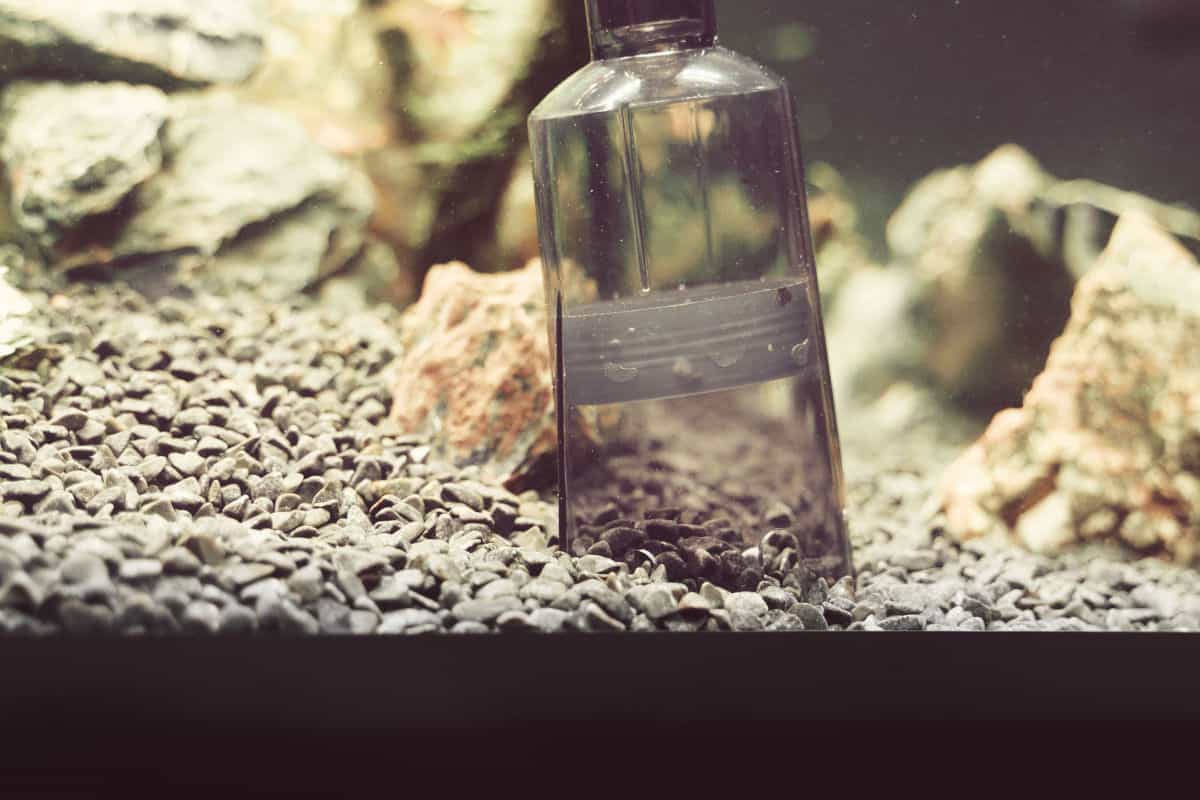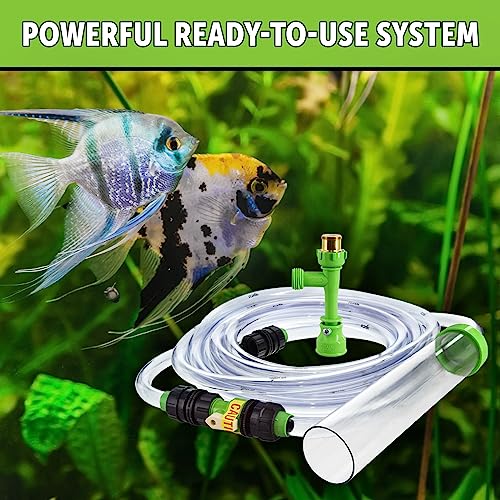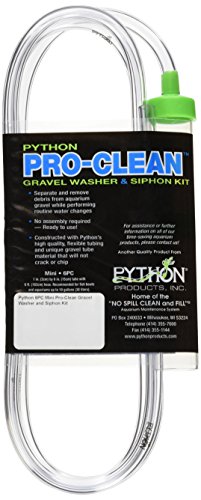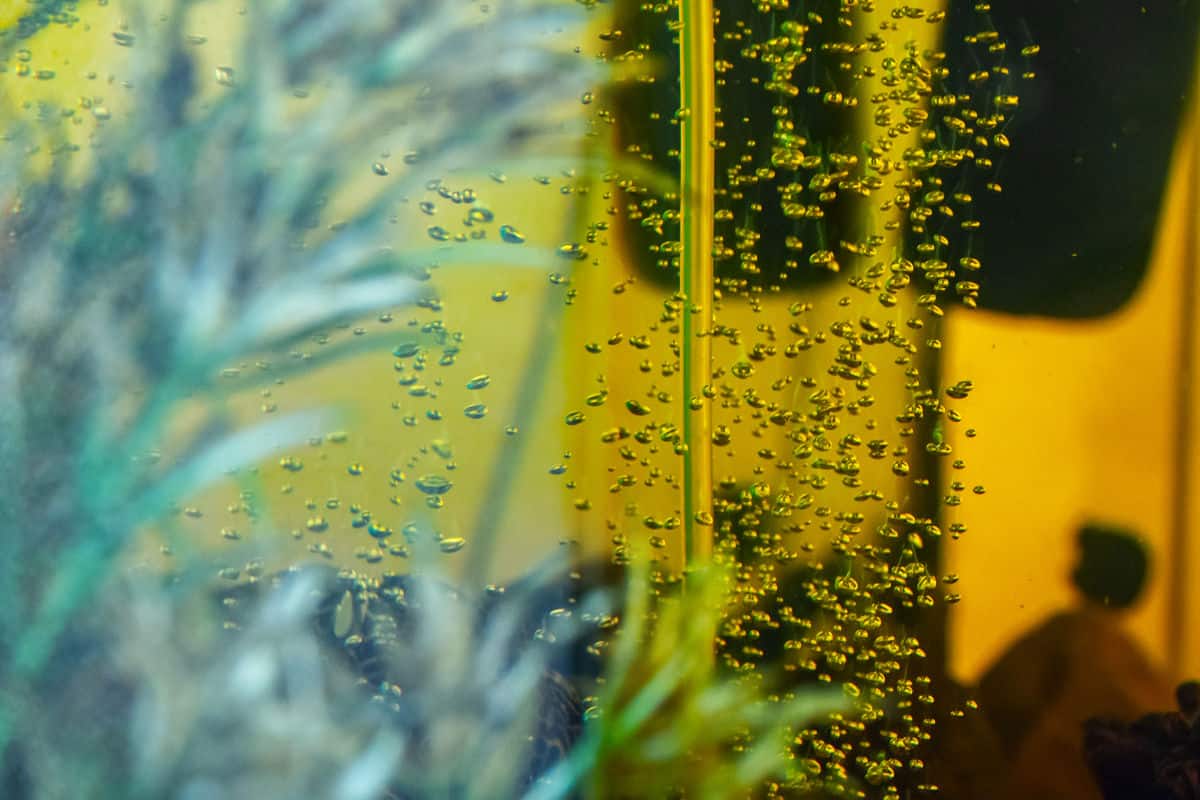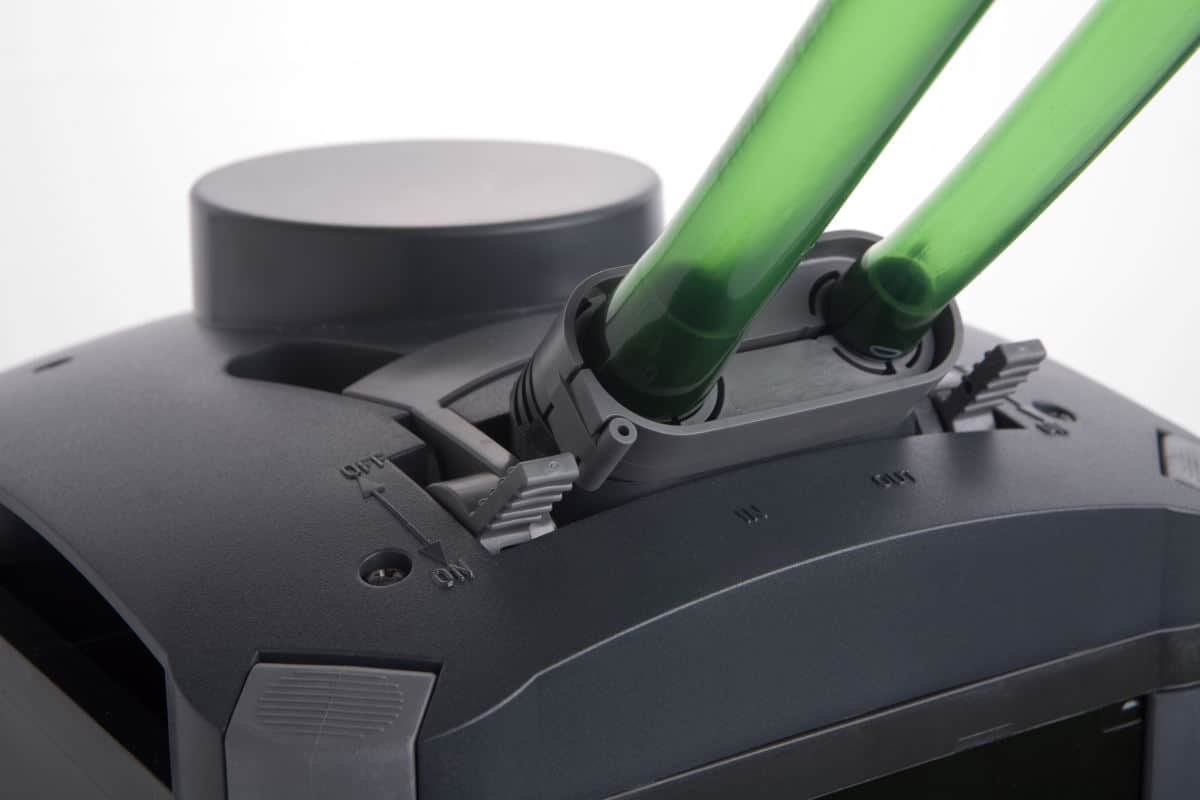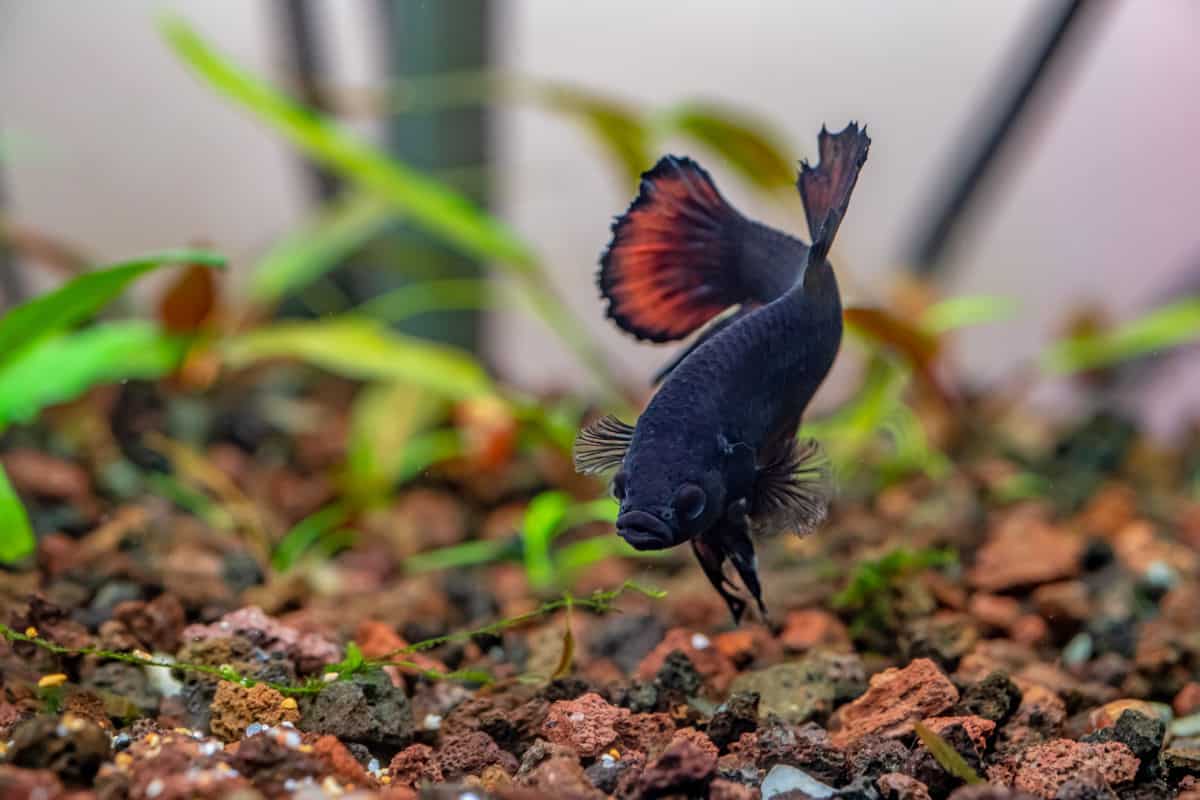In this short guide, we help you find the best aquarium vacuum gravel cleaner to suit your particular tank size and set up.
If you enjoy and manage an aquarium, whether you’re a beginner or an expert, you already know that keeping it clean is one of the most important aspects of the hobby.
Keeping your aquarium clean will ensure your fish and other creatures stay healthy and thrive, and it will provide you with a beautiful tank to look at that you can be proud of.
Probably the most important aspect of a clean aquarium is fresh, filtered water. But even filtered, supposedly clean looking water can contain hidden nasties if your gravel isn’t regularly cleaned.
That’s where gravel vacuums come in. These handy devices take the hassle out of keeping your aquarium clean and beautiful.
This guide to the best aquarium gravel cleaners will help you understand the benefits and importance of using one, and we share some of our top picks with you too.
The Top Models Chosen for our Aquarium Vacuum Cleaner Reviews
- For 55 gallons+: Python No Spill Clean and Fill 25 Foot System
- For 20 to 55 gallons: Python Pro-Clean Gravel Siphon Kit
- For 1 to 20 gallons: TOM Aquarium Gravel Vacuum 12-Inches Length
- Best electric: Eheim Quick Vac Pro Automatic Gravel Vacuum Cleaner
Please note: The above links take you to current prices, customer reviews and further information on Amazon.
Contents (click to topic)
- 1 Best Aquarium Vacuum Cleaner – Our Top Recommendations for Different Tank Sizes
- 2 Best Gravel Vacuum for Large Tanks
- 3 Best Aquarium Gravel Vacuum for Medium Sized Tanks
- 4 Best Aquarium Siphon and Gravel Cleaners for Small Tanks
- 5 Best Electric Aquarium Vacuum
- 6 What is an Aquarium Vacuum Gravel Cleaner?
- 7 The Importance of Keeping Your Gravel Clean
- 8 What to look for in the Best Aquarium Vacuum Cleaner
- 9 Best Gravel Vacuum FAQ
- 10 Conclusion
Best Aquarium Vacuum Cleaner – Our Top Recommendations for Different Tank Sizes
Not all vacuums are right for all tanks, so we’ve split our recommendations into different groups for different tank sizes.
We’ll work our way through going from large, through medium to small tanks, and finish on a single electric model for those who like their gadgets.
It’s important to get a gravel cleaner suitable for your tank size, because if too small for a large tank you will not be able to reach the bottom easily, and it will take a long time.
On the flip side, if too large for a small tank, you risk emptying it out of water before you’ve had a chance to clean all the gravel.
So browse the options below to find the best aquarium gravel that’s right for you and the fish tank you own.
Best Gravel Vacuum for Large Tanks
We’ve 2 options for you here that are suited to tanks that are 55 gallons or larger.
Be warned, these will NOT be suitable for tanks smaller than 55 gallons. They will empty the water too fast, before you have a chance to clean much waste and solids from the gravel.
Python No Spill Clean and Fill Aquarium Maintenance System
This first model in our roundup is actually a 2-in-1 product, and the only one of its type to feature. Not only can it vacuum your gravel and empty dirty water from your tank, but it can also be used to fill it back up too!
The Python is designed to fit a faucet with a supplied universal adapter that will fit almost all taps, and uses suction created by running water from the tap to siphon water from your tank. To vacuum out dirt and debris, you simply aim the end of the tube in your tank at the area you wish to vacuum.
Once finished, you close a valve on the tube and one on your faucet, and then it’s role reverses, directing water from the tap back into your aquarium to replace water that was removed during your cleaning.
It comes with an impressive 25-foot hose that should suffice to reach from most peoples aquariums to either a kitchen or bathroom tap. However, if this length is not sufficient, they also have a 50-foot model, or it’s relatively easy to source fixings from your local hardware store to extend this even further, as many owners have indeed done.
So if you’re looking for a system to vacuum for gravel, remove dirty water from your tank and replace it with fresh, with no need for buckets or to and fro trips from your aquarium to a drain, this may well be the model you’re looking for.
Pros
- Good for large tanks up to almost any size.
- Can empty water, vacuum waste and refill with water, all in one unit.
- Up to 50 foot hose for easy reach to a kitchen or bathroom sink.
- No buckets, containers or trips to a drain required.
- High flow rate for quick clean-up and refill.
- Solid construction, with brass fixings made to last.
Cons
- Relatively expensive compared to others in this list.
Lee’s Ultra GravelVac, Self-Start with Nozzle & Hose Clip
Compared to the Python above, this is your more typical looking and functioning gravel cleaner.
Designed for large tanks, it has a 16″ tall siphon to help you reach into every corner, and a 6-foot hose to make sure it can reach out of your aquarium and down into a bucket or container.
It’s a self-starting or self-priming type so to get it going, all you do is move the end of the syphon up and down in the water, and it will begin to flow.
It has an extra wide nozzle which helps you cover more gravel in a shorter time and hence speed up cleaning, and also includes hose clips you can attach to your bucket to help prevent unwanted spills and free up your hands to concentrate on the vacuuming of debris.
Although it may look very basic, it’s a well-designed piece of equipment that does it’s intended job well.
Pros
- 6-foot long hose for easy removal of water and debris.
- High flow rate for quick clean-up.
- Solid construction.
Cons
- High flow rate won’t work with small or medium size tanks.
Best Aquarium Gravel Vacuum for Medium Sized Tanks
We now take a look at a couple of models that will suit your more medium sized tanks, from 20 to 55 gallons in size.
Python Pro-Clean Gravel Washer and Siphon Kit for Aquarium
This particular model from Python is designed to suit aquariums in the 20 to 55-gallon range. Any smaller, it will empty the tank too quickly, any larger and it will take too much time and be hard to reach into every corner of the aquarium to get every inch of gravel cleaned.
This is a simple looking model, with a straight cylindrical tube, a 15″ nozzle and 6-foot tube which should be ample for any aquariums that fall within the specified range of 20 to 55 gallons.
It’s self-priming, just pump the end up and down a few times in the water to start the siphoning action.
The 15″ length of the cylinder is long enough to allow you to really dig into the gravel and suck it up before it reaches only part way up the tube and falls back to the aquarium floor. Shorter models sometimes suffer from gravel reaching the top of the tube and blocking the tube, but not so with this model.
The cylinder and tubing are made from flexible, high-quality materials that will not crack, chip or suffer damage during normal use.
Pros
- Easy to use.
- Fast and powerful sucking action.
- Durable tubing and plastic.
Cons
- You must start the suction yourself.
- May suck water too fast to clean the gravel in one shot for the smaller tanks in the range of 20 gallons.
Aqueon Medium Siphon Gravel Cleaner
This self-priming siphon from Aqueon is great for quick, routine partial water changes.
The Aqueon range of siphon vacuums actually come in 4 sizes, suiting tanks from 1 to 40+ gallons. The particular model we’re discussing here is suited to 15 to 35-gallon tanks.
It has a 6-foot hose, more than ample for medium size tanks, and is very easy to start with a simple up and down motion of the end in your aquarium’s water.
It includes a clip to keep the end of the hose in place in your bucket to prevent spills and keep your hands free to do the job.
This model is basic, simple, and plain works. There’s not much else to say.
Pros
- Self-priming – flow starts easily.
- Does not suck up gravel or fish.
- Quick and easy to use.
Cons
- May suck up sand or other fine substrates
Best Aquarium Siphon and Gravel Cleaners for Small Tanks
We’re classing small tanks as those from 1 gallon up to around 15 or maybe 20 gallons at a push.
If you were to use one of the larger models above, it would empty your aquarium too quickly, before you’d had a chance to effectively siphon off debris from with your gravel. These models, however, are ideal.
KollerCraft TOM Gravel Vacuum
This is a powerful little vacuum for a great price. A 12″ vacuum tube combined with a 5-foot hose, makes it perfect for cleaning small to medium tanks.
It has a wide end on the cylinder to cover a greater area quicker, allowing you to clean all your gravel before too much water is removed.
Adjustable flow control means you can siphon the water and crud out of your aquarium in minutes.
To start the siphon action, somewhat unique to this model you squeeze a starting pump in the handle, and it soon begins to suck water. We’re not saying the up and down motion start of most others in this list is difficult anyway, but the ease of starting this one is another level.
Leading on from this, the rapid up and down motion start of other models can cause strong currents in small tanks, which can startle and stress your fish. The hand pump start action of the Kollercraft Tom avoids this.
Although this vacuum is meant for smaller tanks, it works just as well on medium tanks if you don’t mind getting your hand wet and taking a little extra time?
Pros
- Inexpensive
- Powerful, but not strong enough to suck up gravel or little fish.
- Pump action siphon for easy starting.
- Extra long hose for easy water changes.
Cons
- Siphons water very quickly, even with the adjustable flow control.
- Large debris may clog the thin tubing.
Python Pro Clean-Mini 1″ x 6″ Tube with 6 ft. Hose
This no frills device works well with small aquariums, up to 10 gallons in size. Ideally suited to your 1, 3, and 5 gallon models, where the others in this list are perhaps too powerful and fast working.
Made with the same ‘no chip or crack’ material the larger and more expensive siphons in Pythons range, this small model is still built to last.
Suction and flow are both fairly light, which makes it perfect for routine maintenance when you’re removing just a bit of water and debris.
The hose is 6 foot and hence ample for reaching down into your bucket or container to collect siphoned out water and solids.
Pros
- Light suction won’t remove fish, gravel, or sand
- Water flow is minimal, making it perfect for small tanks.
- Heavy-duty tubing won’t split or crack.
Cons
- Being so small, very large debris may block the tube, but this is something you have to deal with a small tank as models with thicker tubing are too powerful.
- Suction isn’t strong enough to clean out the heaviest debris
Best Electric Aquarium Vacuum
So far all the models in this guide have been ones that require starting or priming by the user, but not the final one on this list that runs on batteries!
This electric gravel vacuum takes ease of use to a whole new level!
EHEIM Quick Vac Pro Automatic Gravel Cleaner
This model is specifically designed for the sole task of removing solid debris from gravel or bottom of your aquarium, it does not remove any water.
So unlike the other vacuums in this article, the EHEIM gravel cleaner doesn’t require buckets or hoses, it doesn’t remove water from your tank.
Instead of using this for or during water changes, you would use it to clean the gravel between changes. It is perfect for removing uneaten food after every feeding session, which you should only allow to last for a couple of minutes anyhow.
The operation is simple, you just place the end into your gravel and press a button. Water is sucked into the vacuum, solid particles – the tiniest of particles – are caught in a fine mesh cartridge before the water is returned to the tank.
The cartridge is also very easy to remove and clean once full or it begins to clog.
It is battery operated and fully submersible up to three feet deep.
Pros
- Use for spot maintenance between water changes
- Very easy to use – no buckets, hoses, or siphoning required
- Picks up debris and filters water back into your aquarium
- The closest to an automatic gravel cleaner you will find
- Battery lasts up to four hours
- Batteries included
Cons
- Aquarium must be at least 12 inches deep.
- Filter must be cleaned fairly often for proper suction
What is an Aquarium Vacuum Gravel Cleaner?
It is a device used to remove dirt and debris from your tank, especially that from the bottom of your tank that lies on, and between the substrate in your tank, particularly gravel.
There are two main types:
- One that’s designed to siphon water out of your tank so you can then replace the dirty water with clean. While removing the water, you can aim the end of the siphon tube to vacuum up and remove fish waste and uneaten food with it.
- A second type sucks up water and returns it to the tank, using a fine mesh to filter out and trap dirt and debris, without removing water from the tank.
Both types are incredibly helpful tools to use for removing waste and debris from your tank.
The Importance of Keeping Your Gravel Clean
Why would you need to vacuum or syphon the gravel in your tank, if you’ve a filter that’s designed to keep the water clean?
Well, there are many benefits to using such a tool, let’s take a close look at them now.
Remove Debris From the Bottom of Your Tank
Gravity is always at work in your aquarium, and everything ends up in the gravel at the bottom of your tank – food waste, fish waste, and plant waste.
Gravel that isn’t properly cleaned will eventually turn into a sludgy, slimy mess, and pollutants will take over your tank.
Unless you like to remove the entire contents of your tank, the water, the fish, and then all the gravel before giving it a proper clean, a gravel vacuum is a god send. Cleaning gravel the old traditional way is time-consuming, messy grunt work that most of use would like to avoid.
Using a good tank vacuum cleaner prevents this arduous need. A routine vacuum for a few minutes each few days, can completely remove the need to ever have to remove and clean your gravel.
Relieves Your Filtration System – Longer Time Between Cleaning
Using a gravel vac to remove fish waste and uneaten food from the bottom of your tank prevents it from decomposing and polluting the water.
A filter can only clean the water that passes through it, but rotting solids in gravel do not pass through the filter. They must pollute the water first.
By removing the solids before they get the chance to rot and pollute the water, you keep the water far cleaner, relieve some pressure on your filtration system and increase the time necessary between large water changes and when you must clean out your filter.
Improve Your Tank’s Chemistry
When pollutants build up in your tank, there will also be a build-up of nitrites and ammonia, which will negatively affect your tank’s chemistry. Harmful bacteria and pollutants will add to the problem, leading to a decreased immunity of your marine life.
Make Your Fish Happy
Pollutants and toxin build-up in your gravel will contribute an unhealthy balance to the bacteria that thrive in your tank.
Not all bacteria is bad for your aquarium — some bacteria will help maintain a healthy environment for your marine life – but some can be bad, those that might colonize decomposing waste and uneaten foods. It’s best to prevent this if possible.
Improve the Look of Your Aquarium
You probably wouldn’t even consider keeping fish if you didn’t enjoy the aesthetics of your aquarium. Keeping your gravel clean is one of the easiest things you can do for a lush, beautiful aquarium, teeming with fish.
If your gravel is riddled with decomposing mess, any time a fish of yours goes for a little rummage, clouds of debris will rise up into your tank and it just doesn’t look good. So vacuum out that junk!
Now that you know why keeping your aquarium gravel clean is so important, let’s take a look at the best tools to get the job done quickly and efficiently.
What to look for in the Best Aquarium Vacuum Cleaner
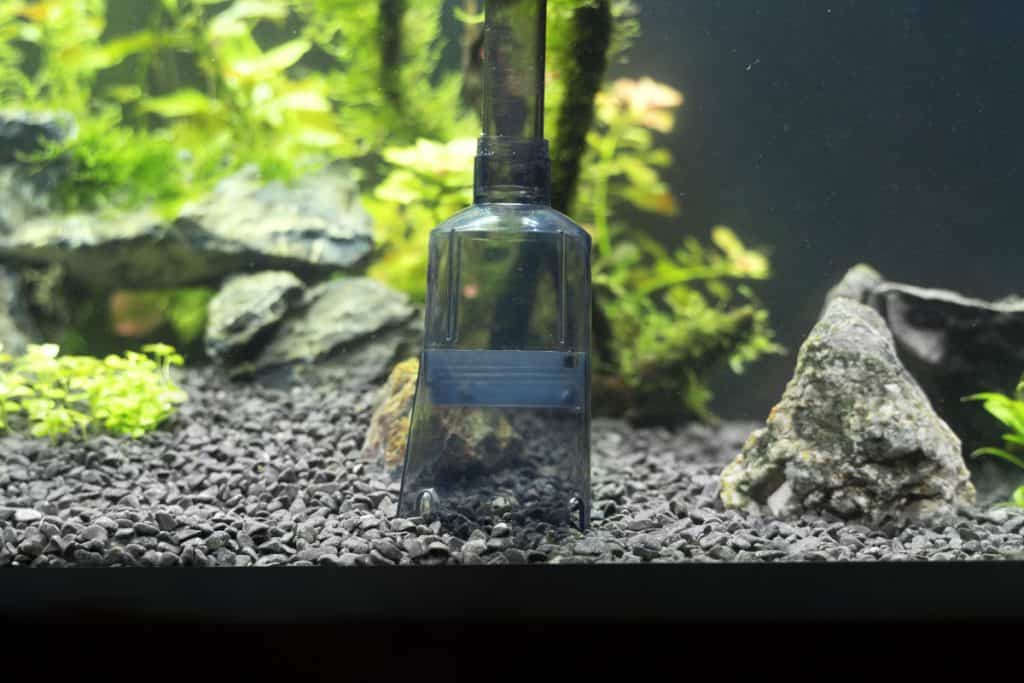
Like most things, not all aquarium gravel vacuums are created equal.
Manufacturers have created a wide range of models, from self-priming long slim cylinders to battery operated models. Some have short tubes, some up to 25 foot, some can empty a 50-gallon tank in minutes, some would take half an hour to do so…
In this section, we take a look at what you need to consider when looking for the best aquarium vacuum cleaner for your needs.
Fast starting / Self-Priming
Gone are the days you would have to insert one end of a hose into your tank and suck on the other end to get the water flowing.
Almost all models are now self-priming, usually by you simply ‘pumping’ the end of the siphon up and down in the water to start it. However, not all models have this quick and easy start feature, so we recommend making sure the one you choose does.
Note: All the gravel vacuums in our list are self-priming, no sucking by you required!
Cylinder Diameter
The diameter of your vacuum and it’s connected tube directly influences how much water is sucked up through the syphon and out of your tank.
If you have a small 5 or 10-gallon tank, you will want a thinner model than you would if you had a 100 gallon+ tank. If your syphon is too large and efficient for your somewhat small tank, you will have emptied the water before you’ve had the chance to give the gravel a good vacuum, which kind of defeats the purpose.
So make sure you get the right size of vacuum for your aquarium. We will help you with this in each model’s notes.
Cylinder Length
The length of your vacuum is also important because you want to be able to reach into every corner of your aquarium, to clean every inch of gravel.
If your siphon cylinder is too short, you might struggle to reach the bottom of your tank, particularly into the corners, if you have a very large tank.
On the opposite end of the scale, if you have a small or wide and shallow tank, you must not get a siphon that’s too long. Otherwise, you might not be able to submerge it fully and then it will not even work.
A length of perhaps 1/2 to 2/3rds the height of the water in your tank is ideal in our opinion.
Hose Length
You want your hose to be long enough to reach up out of the tank, and down into the bottom of wherever you place your container to catch the water. Make sure you keep this in mind when considering your options!
Aquarium Size
We already touched on this above with the diameter of your siphon and tubing, but it’s worthwhile repeating.
All of the models we discuss below will have written in their description the size of tank they are best suited to. Please do make sure to get one appropriate for your size of tank. Otherwise, it will not work well and you likely then won’t bother to use it.
Best Gravel Vacuum FAQ
A few commonly asked questions, to which we will add to as time goes by:
How to Use a Gravel Vacuum
Once you’ve purchased your gravel vacuum, you will of course want to know how to use it! However, the instructions on many are often poor, or even non-existent.
Therefore, we’ve put together an article detailing exactly how to use a gravel vacuum, with step by step instructions and video.
Do They Produce Good Results?
A gravel vacuum is an effective and inexpensive way to remove sediment and debris from substrate at the bottom of an aquarium.
Because they are manually operated, they do require some effort to use, and there’s a bit of a learning curve as you develop the technique of creating suction. Once mastered, they are simple to operate. It’s a must-have for aquariums without an undergravel filter.
How Does a Gravel Cleaner Work?
A gravel vacuum uses the principle of suction to remove debris from the substrate. They are manually operated and simple to use. They are made of a large cylindrical chamber attached to a long hose, the chamber is raked through the gravel where it pulls up any debris resting on or hiding between the stones. Waste and water are carried up and out through the tube and into a bucket. The gravel is too heavy to suck up and settles back down to the bottom.
For a complete look at and how to on their use, click the following link: https://www.caringpets.org/how-to-take-care-of-a-goldfish/aquarium-gravel-cleaner/
How Often Should I Use a Vacuum?
The answer depends on how many fish are in your aquarium, and what type. Some fish, like goldfish, produce a lot of waste meaning frequent cleanings are needed to keep the water safe. Most aquariums will need a cleaning and partial water change weekly. Time your vacuuming to coordinate with water changes since you’ll be removing water, anyway.
Are There any Dangers to Using One?
There are some risks involved with the use of a gravel vacuum, but these can be reduced through careful use.
Very small fish, including fry, and other creatures like shrimp and frogs, are small enough to be sucked up into the vacuum chamber. Only the very smallest will actually be able to travel up the tube, however.
Also, be on the lookout for burrowing fish hiding under the gravel. Plunging the vacuum into the debris and hitting a fish can severely injure or even kill the unsuspecting fish.
Keep an eye on the exit end of your vacuum to avoid accidentally discharging aquarium water onto the floor.
Conclusion
A weekly cleaning is all that’s needed for cleaning up the debris on the bottom of most tanks.
Simply run the vacuum tube along the bottom of your tank, gently stirring up the gravel as you go. Most clean-ups can be completed in minutes, whether you choose an electric model or a manual siphon.
No matter how big or small your aquarium, you will find that a gravel vacuum makes easy work of one essential task toward keeping your tank healthy and beautiful.

